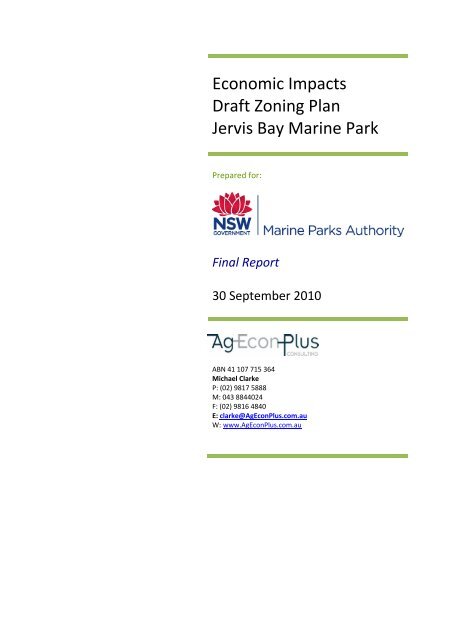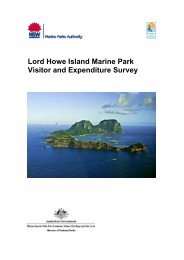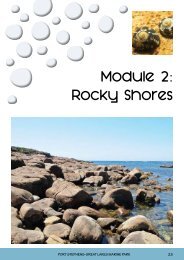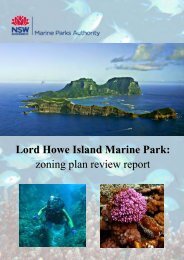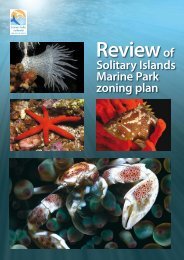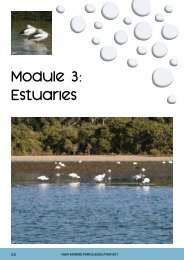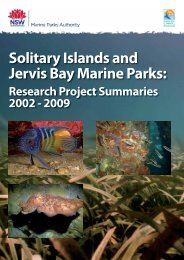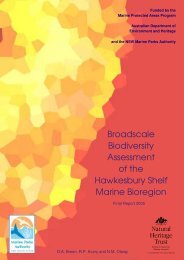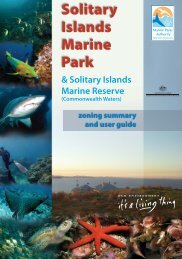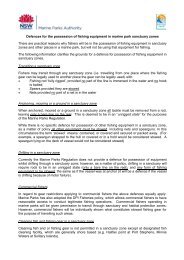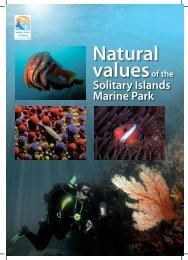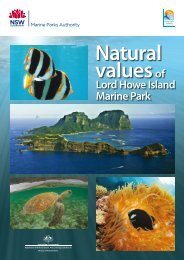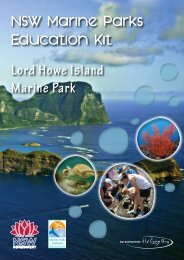Economic Impacts - Draft Zoning Plan Jervis Bay Marine Park
Economic Impacts - Draft Zoning Plan Jervis Bay Marine Park
Economic Impacts - Draft Zoning Plan Jervis Bay Marine Park
You also want an ePaper? Increase the reach of your titles
YUMPU automatically turns print PDFs into web optimized ePapers that Google loves.
TABLE OF CONTENTSExecutive Summary ............................................................................................................. 31. Introduction ................................................................................................................ 41.1 Impact Assessment Purpose and Scope..............................................................41.2 Background .....................................................................................................51.3 Project Method................................................................................................62. Commercial Fishing...................................................................................................... 82.1 Description of JBMP Commercial Fishing............................................................82.2 <strong>Zoning</strong> <strong>Plan</strong> Changes that Impact Commercial Fishing .........................................92.3 Assessment of <strong>Zoning</strong> <strong>Plan</strong> <strong>Impacts</strong> on Commercial Fishing ...............................103. Aquaculture .............................................................................................................. 124. Recreational Fishing................................................................................................... 124.1 Description of JBMP Recreational Fishing .........................................................124.2 <strong>Zoning</strong> <strong>Plan</strong> Changes that Impact Recreational Fishing ......................................144.3 Assessment of <strong>Zoning</strong> <strong>Plan</strong> <strong>Impacts</strong> on Recreational Fishing...............................145. Commercial <strong>Marine</strong> Tourism Activity ........................................................................... 165.1 Description of JBMP Commercial <strong>Marine</strong> Tourism Activity .................................165.2 Assessment of <strong>Zoning</strong> <strong>Plan</strong> <strong>Impacts</strong> on Charter Fishing......................................165.3 Assessment of <strong>Zoning</strong> <strong>Plan</strong> <strong>Impacts</strong> on Scuba Diving/Snorkelling........................175.4 Assessment of <strong>Zoning</strong> <strong>Plan</strong> <strong>Impacts</strong> on <strong>Marine</strong> Mammal Watching.....................175.3 Assessment of <strong>Zoning</strong> <strong>Plan</strong> <strong>Impacts</strong> on Other Commercial Recreation ................176. Other Recreation ....................................................................................................... 177. Local Business Activity Dependent on JBMP ................................................................. 198. Property Prices .......................................................................................................... 199. Summary and Conclusions.......................................................................................... 2010. References ................................................................................................................ 21Abbreviations and GlossaryDECCWDEWHAI&IJBMPMPMPATRAZPNSW Department of Environment, Climate Change and WaterAust Govt Department of Environment, Water, Heritage and the ArtsNSW Department of Industry and Investment<strong>Jervis</strong> <strong>Bay</strong> <strong>Marine</strong> <strong>Park</strong><strong>Marine</strong> <strong>Park</strong>NSW <strong>Marine</strong> <strong>Park</strong>s AuthorityTourism Research Australia<strong>Zoning</strong> <strong>Plan</strong><strong>Economic</strong> <strong>Impacts</strong> of <strong>Draft</strong> JBMP <strong>Zoning</strong> <strong>Plan</strong>Page 2FINAL
Executive SummaryThe purpose of this study was to identify, quantify and where possible value economicimpacts which may occur in commercial and non‐commercial activities as a result ofrecommended changes to the current zoning plan for the JBMP.The study was completed as a desk‐based research exercise. <strong>Economic</strong> impacts wereassessed for commercial fishing and aquaculture, recreational fishing, commercial marinetourism, other recreation, local business dependent activity and property prices.Key findings include: Commercial fishing – minor negative economic impacts. <strong>Impacts</strong> focussed onrelatively small changes for single purse seiner and up to seven demersal trawlers.<strong>Economic</strong> loss to seven demersal trawlers was estimated to total $777 per annumin producer surplus or $11,098 gross. No net impact on Abalone catch. Recreational fishers – zoning plan changes include both positive and negativedevelopments for recreational fishing. On balance, no net change in economicvalues. Other recreation ‐ recreational activities in the JBMP will not be adversely affectedby changes to the zoning plan and minor incremental additional benefits will becreated. Local businesses – no change in economic values attributable to the zoning plan. Property prices – property prices are not likely to be impacted by the minorchanges in economic values described in this report.Relocating the St Georges Head ‐ Steamer Head sanctuary zone north is the only proposedchange to the zoning plan receiving a high concentration of stakeholder response.<strong>Economic</strong> costs to commercial and recreational fishing associated with this change werefound to be mitigated by access to a new alternative reef area. Minor economic impactsare also experienced in association with trawl access changes and purse seining.Recreational benefits may be realised by creating new restrictions on boats and jet skis.The paucity of data and the minor nature of changes have prevented quantification of alleconomic impacts.<strong>Economic</strong> <strong>Impacts</strong> of <strong>Draft</strong> JBMP <strong>Zoning</strong> <strong>Plan</strong>Page 3FINAL
1. Introduction1.1 Impact Assessment Purpose and ScopeThe purpose of this report was to provide the NSW <strong>Marine</strong> <strong>Park</strong>s Authority (MPA) with aneconomic impact assessment of draft changes to the <strong>Jervis</strong> <strong>Bay</strong> <strong>Marine</strong> <strong>Park</strong> (JBMP) zoningplan.Specifically, the objective of the study was:To identify, quantify and where possible value economic impacts which may occur incommercial and non‐commercial activities as a result of recommended changes to thecurrent zoning plan for the JBMP.<strong>Economic</strong> impacts relate principally, but not exclusively, to changes in the level, type andvalue of commercial and recreational fishing and general recreational activity.It is important to note that conclusions drawn from this study need to be tempered by thelack of an appropriately comprehensive commercial and recreational fishing data set forthe JBMP at a geographic scale that would directly inform development of the zoningplan. The results contained in this report are based on information provided by <strong>Marine</strong><strong>Park</strong> staff, officers at DECCW and NSW Department of Industry and Investment (I&I).The impact assessment is part of a wider review process that includes preparation of azoning plan review report (MPA 2009). Preparation of the zoning plan review reportincluded community consultation. The review process is a statutory requirement toensure that zoning plans protect the important natural and cultural values of the marinepark, while providing for a range of sustainable uses including beach activities, swimming,surfing, commercial and recreational fishing, scuba diving, whale and dolphin watching,sailing, boating, research and other activities (MPA 2009).The <strong>Jervis</strong> <strong>Bay</strong> <strong>Marine</strong> <strong>Park</strong> spans 100km of coastline and covers an area of 214 km 2 .Figure 1.1 below shows the location of <strong>Jervis</strong> <strong>Bay</strong> <strong>Marine</strong> <strong>Park</strong> and 2002 zoning planboundaries.<strong>Economic</strong> <strong>Impacts</strong> of <strong>Draft</strong> JBMP <strong>Zoning</strong> <strong>Plan</strong>Page 4FINAL
Figure 1.1JBMP Location and 2002 <strong>Zoning</strong> <strong>Plan</strong> Boundaries1.2 BackgroundThe MPA is currently reviewing the zoning plan (ZP) for <strong>Jervis</strong> <strong>Bay</strong> <strong>Marine</strong> <strong>Park</strong> whichensures the conservation of biodiversity in the marine park and regulates its use. Part ofthe review process has involved producing a draft zoning plan which incorporates changesrecommended in earlier zoning plan review reports for the parks. These changes weresubsequently announced by Ministers Sartor and Whan in April 2010 as below:JBMP recommendations:o Prohibit commercial trawling and lift netting activities in the marine park;o Relocate St Georges–Steamers Head Sanctuary Zone northward without increasingthe sanctuary zone area, but provide a 100m wide habitat protection zone to allowrock fishing;o Reconfigure one purse seining area within <strong>Jervis</strong> <strong>Bay</strong> and remove a purse seiningarea adjacent to Bowen Island;o Improve manageability at the Drum and Drum Sticks by straightening zoneboundaries;o Designate an anchoring area in Hare <strong>Bay</strong> sanctuary zone to facilitate public use;o Prohibit the use of jet skis at Hyams Beach to facilitate public use and enjoyment;o Restrict spearfishing and boating in Honeymoon <strong>Bay</strong> to improve public safety; ando Restrict motorised vessel access to Carama Inlet and Moona Moona Creek tobetter protect shallow water habitats.<strong>Economic</strong> <strong>Impacts</strong> of <strong>Draft</strong> JBMP <strong>Zoning</strong> <strong>Plan</strong>Page 5FINAL
The Ministers media release can be found at:www.environment.nsw.gov.au/resources/MinMedia/MinMedia10041901.pdfFurther information on the proposed changes, background research, and the widerconsultation process can be found at: http://www.mpa.nsw.gov.au/jbmp.html1.3 Project MethodThe project was completed through a process that involved desk‐based research,collation, analysis and write up of secondary data from published and unpublished sources(see project reference list and Table 1.1 below), and discussions with DECCW <strong>Marine</strong> <strong>Park</strong>Managers, NSW Department of Industry and Investment (I&I) and Department ofEnvironment, Climate Change and Water (DECCW) staff and CARE Pty Ltd.The project required:o Description of commercial and non commercial MP activities;o Documentation of the impact of zoning plan changes on MP activities;o Identification of background trends relevant to the MP activity – Figure 1.2 below;o Estimation of net incremental physical impacts of ZP changes;o Analysis and quantification of economic impacts; ando Project reporting.A standalone chapter was prepared for each set of MP activities.Table 1.1Possible Sources of Information to Estimate Changes in <strong>Economic</strong> ValuesExample of activityCommercial fishing andaquacultureRecreational fishingCommercial marine tourismactivity e.g. charter fishing,diving, marine mammal watchingRecreationLocal business activity dependenton MPProperty pricesPossible information source/proxy measureI&I catch recordsMP reports and surveysInformation from unpublished NSW <strong>Marine</strong> park licensingprojectInformation on patronage of toursMPA recreational surveys of JBMPBusiness surveys (2005, and forthcoming)Valuer‐General information and online data (egdomain.com)Source: MPA Project Brief<strong>Economic</strong> <strong>Impacts</strong> of <strong>Draft</strong> JBMP <strong>Zoning</strong> <strong>Plan</strong>Page 6FINAL
Figure 1.2Possible Background Trends in MP activitySome exogenous factors which may influence commercial and non commercial activitiesin JBMP include the following.SocialIn migration of retirees and others to coastal townsAging of resident population and new arrivalsObesity and healthLonger working lifeDual income familiesAboriginal communitiesChanging holiday patterns (e.g. short breaks, road trips)Community awareness of environmental impacts/climate changeTechnologicalBetter road access but increasing petrol pricesTrend to 4‐wdsInternet, electronic communication/mobilesTeleworking<strong>Economic</strong>Health care costs for aging populationsHousing affordabilitylonger working life/quasi‐retirementDual household incomes – part‐time workIncreasing petrol pricescoastal residential developmentdecline in regional economic importance of primary industryincrease in service sectorrising interest rates for housing loansCost of housing /rents in Sydney (Newcastle, Canberra)EnvironmentalClimate change re drought, coastal processes etc.decline of fisheries/ fish stockswater quality and quantity for coastal lakes/estuaries, urban water suppliesPolitical/institutional trendsworkplace /industrial agreementscreation of NSW multi‐purpose MPAscreation of Commonwealth marine parksother environmental protection legislationStructural adjustment programs for NSW and Commonwealth fisheries.Continued economic growth in the region is likely to affect the MP in at least two ways:by increasing pressure on the environmental resources and hence management of the<strong>Park</strong>; and also by increasing the value derived from the <strong>Marine</strong> <strong>Park</strong>.Source: MPA Project Brief<strong>Economic</strong> <strong>Impacts</strong> of <strong>Draft</strong> JBMP <strong>Zoning</strong> <strong>Plan</strong>Page 7FINAL
2. Commercial Fishing2.1 Description of JBMP Commercial Fishing<strong>Jervis</strong> <strong>Bay</strong> is an important habitat for fish recruitment to the surrounding commercialfisheries. Only limited commercial fishing occurs in JBMP and much of it is for bait(AgEconPlus 2008).NSW I&I data for Ocean Zone 8 relates to NSW ocean waters between S35o (immediatelynorth of Currarong), and S36o (south of Moruya). This area includes, but is not limited to,the JBMP has yielded approximately 1,830 tonne of production with an annual averagemarket value of $5.4 million between 1997‐98 and 2008‐09 1 .Table2.1Commercial Wild Harvest ‘In or Adjacent to the JBMP’#Year Weight (tonnes) Value ($’000) Number of FishingBusinesses1997‐98 1,969 5,311 1661998‐99 1,620 4,517 1681999‐00 1,816 5,257 1462000‐01 1,900 5,538 1432001‐02 2,140 6,511 1292002‐03 1,740 4,997 1102003‐04 1,735 4,449 962004‐05 1,989 4,858 922005‐06 1,745 5,044 912006‐07 1,640 5,241 852007‐08 1,829 5,817 752008‐09 1,843 6,708 66Source: I&I Fisheries Resource Management Branch, September 2010# Includes estuary general, fish trawl, ocean hauling, ocean prawn trawl and ocean trap and line.Prior to the establishment of the MP zoning plan in 2002 the NSW Government completeda buy out of 17 fishing businesses and reduced estuary general commercial fishing activityin the enclosed waters of <strong>Jervis</strong> <strong>Bay</strong> (see Figure 2.1). Commercial fishing in the ocean zoneoutside <strong>Jervis</strong> <strong>Bay</strong> has been relatively stable since at least 1997‐98 (MPA 2009).1Note the north of JBMP includes a small fraction of Ocean Zone 7. Given its small size and capacity to distort,Ocean Zone 7 data has not been included in Table 2.1.<strong>Economic</strong> <strong>Impacts</strong> of <strong>Draft</strong> JBMP <strong>Zoning</strong> <strong>Plan</strong>Page 8FINAL
Figure 2.1<strong>Jervis</strong> <strong>Bay</strong> Estuary Catch 1997-98 to 2006-07 (kg)Source: MPA 2009Structural adjustment has removed most of the commercial fishing industry from inside<strong>Jervis</strong> <strong>Bay</strong> and the bait fishing industry has also contracted (NSW MPA advice). There areseveral Indigenous fishers at Wreck <strong>Bay</strong> and Orient Point. From interviews completed in2004 and 2009 it was apparent that there are a small number of fishers to whom theJBMP area is still an important source of income. There are many fishers to the north andsouth of <strong>Jervis</strong> <strong>Bay</strong> who make no use of the bay, preferring to fish in deep water outsideMP limits (AgEconPlus 2009).Commercial fisheries that may operate in the marine park are the Estuary general fishery;Lobster fishery, Ocean hauling fishery, Ocean trawl fishery, Ocean trap and line fisheryand Abalone fishery (MPA 2009).2.2 <strong>Zoning</strong> <strong>Plan</strong> Changes that Impact Commercial Fishing<strong>Draft</strong> zoning plan changes that will impact on commercial fishing in the JBMP include:o Prohibition of commercial trawling and lift netting activities in the marine park;o Relocation of the St Georges‐Steamers Head Sanctuary Zone northward withoutincreasing the sanctuary zone area, but provide a 100m wide habitat protectionzone to allow rock fishing; ando Reconfiguration of one area within <strong>Jervis</strong> <strong>Bay</strong> and remove an area adjacent toBowen Island.<strong>Economic</strong> <strong>Impacts</strong> of <strong>Draft</strong> JBMP <strong>Zoning</strong> <strong>Plan</strong>Page 9FINAL
2.3 Assessment of <strong>Zoning</strong> <strong>Plan</strong> <strong>Impacts</strong> on Commercial FishingProhibition on Lift NettingA prohibition on lift netting in JBMP is proposed. Lift netting is not practiced in the JBMPand no licences are issued by I&I for this purpose (AgEconPlus consultation and analysis).It is noted that prior to zoning plan changes there existed an ‘option value’ for lift nettingin the JBMP that will be extinguished by the policy proposal. While option value isrelevant, it is difficult to quantify.Prohibition of Commercial TrawlingCommercial trawl in JBMP is licensed for demersal finfish species rather than prawns andis a minor activity that is limited to two sites within the park, ie Crookhaven Bight in thenorth and Wreck <strong>Bay</strong> in the south. Crookhaven Bight is trawled infrequently due to thepresence of a reef system that damages trawl nets. Crookhaven Bight is trawled by fewerthan six commercial fishing vessels on an ad hoc basis. It is a minor resource for local trawlbusinesses constituting a small number of total trawl ‘shots’ ie less than 5% of total effort(MPA advice).Wreck <strong>Bay</strong> was set aside as a trawl ‘turnaround area’ under the current zoning plan sothat vessels operating outside the park do not need to lift their nets at the end of a ‘shot’.Wreck <strong>Bay</strong> is used infrequently for this purpose and while it is possible that other trawlersuse Wreck <strong>Bay</strong> as a turnaround area, to the best of the MPA’s knowledge, it is only usedirregularly by a single operator. Change in the zoning plan at Wreck <strong>Bay</strong> to prohibittrawling will result in an inconvenience for this single operator rather than a reduction incatch.Trawl operators have indicated that both Crookhaven Bight and Wreck <strong>Bay</strong> are small partsof their trawl fishing operations ie less than 5% of total effort (MPA pers comm. July2010). <strong>Economic</strong> loss is estimated on the following basis: I&I catch records 1997‐98 to 2008‐09 show an average Fish Trawl Catch in oradjacent to the JBMP of 395 tonnes valued at $1.3 million spread across 41businesses. An earning per business estimate of $31,707 gross. The number of businesses impacted by zoning plan changes is estimated to totalseven ie six in Crookhaven Bight and one in Wreck <strong>Bay</strong>. The gross value of FishTrawl Catch across these seven businesses is estimated to total $221,951 (ie 7 X$31,707). If the full estimated loss to fishing operations is applied ie 5% then total loss acrossseven businesses will gross $11,098 per annum (5% of $221,951) with an estimatedproducer surplus of $777 (producer surplus is 7% of gross earnings).Trawl operators currently fishing Crookhaven Bight and Wreck <strong>Bay</strong> would offset at leastpart of this loss by increasing fishing effort in other areas.Relocation of the St Georges‐Steamers Head Sanctuary ZoneRelocation of the St Georges‐Steamers Head Sanctuary Zone northward will preventaccess to a commercial fishing reef but will ‘free up’ an alternative reef believed to be of<strong>Economic</strong> <strong>Impacts</strong> of <strong>Draft</strong> JBMP <strong>Zoning</strong> <strong>Plan</strong>Page 10FINAL
additional value to commercial fishers – a more detailed discussion of this trade off isprovided under the recreational fishing section below.Although currently closed and not generating economic values, the St Georges‐SteamersHead Sanctuary Zone is a key abalone area (per. Comm., Regional Manager South Coast<strong>Park</strong>s and Wildlife DECCW). Historical values associated with abalone catch are shown inthe table below.Table 2.3 Abalone <strong>Economic</strong> Values JBMP ($’000)Source: I&I September 2010The I&I fisheries data on abalone catch in the JBMP is a at broad spatial scale and arguablytoo broad to accurately quantify the economic values that may be affected by zoningchanges. Abalone catch data is grouped by Regions and sub zones and the relevant Regionis Region 1 south and the South Sub zones within the JBMP are: Shoalhaven Heads to Currarong Currarong to Point Perpendicular Inside <strong>Jervis</strong> <strong>Bay</strong> North tip Bowen Island to Wreck <strong>Bay</strong>.The proposed changes to the zoning plan would see a loss of some area, but the additionof another area.Reconfiguration of Purse Seining AreaReconfiguration of one purse seining area within <strong>Jervis</strong> <strong>Bay</strong> and removal of an areaadjacent to Bowen Island for purse seining will have implications for this form ofcommercial fishing. Under the current zoning plan two separate areas are available forpurse seining within the bay and are predominantly used by a single commercial fishingbusiness to gather live bait for fishing pelagic species such as tuna and kingfish.Under the proposed zoning plan, the two separate areas, Bowen Island and <strong>Plan</strong>tationPoint would be replaced with a single, larger and more easily identified area off <strong>Plan</strong>tationPoint. While the single easier to fish area is consistent with the single operator’s request,the loss of Bowen Island may result in some economic loss (MPA advice). Bowen Island issuitable for harvesting yellowtail while <strong>Plan</strong>tation Point produces only pilchards. BowenIsland is also a ‘fail safe’ source of bait during poor weather and during winter monthsthat produce cold currents. The current operator purse seines from an ‘open tinny’ and isunable to pursue bait in warmer open waters outside the park.Reconfiguration of the JBMP purse seining area will produce economic impacts ie loss ofbait collecting opportunity during rough winter weather (MPA advice) in turn this mayhave consequences for resultant tuna and kingfish catch. It was not possible to quantifythe magnitude of this economic loss.<strong>Economic</strong> <strong>Impacts</strong> of <strong>Draft</strong> JBMP <strong>Zoning</strong> <strong>Plan</strong>Page 11FINAL
Summary of Commercial Fishing <strong>Economic</strong> <strong>Impacts</strong>Table 2.4ActivityLift netting<strong>Economic</strong> Impact JBMP Commercial FishingNet Incremental Impact ofZP ChangesNot practiced or even licensed inthe JBMP<strong>Economic</strong> Impact of ZP ChangesNo economic impact. The loss of ‘optionvalues’ acknowledged.Commercial trawlPurse seiningAbaloneLoss of minor trawl opportunityCrookhaven Bight for up to 6fishers. Turning zone removed forsingle trawler at Wreck <strong>Bay</strong>.Loss of bait collecting opportunityduring rough winter weather whichmay have consequences forresultant tuna and kingfish catchThe proposed changes to thezoning plan would see a loss ofsome area associated with the StGeorges‐Steamers Head SanctuaryZone, but the addition of anotherarea.Minor economic impact – areasremoved from trawling were a small partof impacted trawl businesses ie less than5% of total trawl effort. Estimated totalproducer surplus loss across 7businesses of $777 per annum.<strong>Economic</strong> cost to a single commercialfishing business ie a proportion ofoverall catch. A small proportion is likelygiven that this change being pursued bythe MPA was instigated by the singlecommercial fishing business.No net change in economic values.While not all of the negative economic impacts on commercial fishers have beenquantified, they are relatively minor in nature.3. AquacultureOyster leases previously established in Currambene Creek were surrendered in the late1990s. Mussel aquaculture occurred in <strong>Jervis</strong> <strong>Bay</strong> near Vincentia from 1977 to early 2008under the authority of a NSW Department of Primary Industries experimental permit (nowI&I). The operation provided a small quantity of product marketed locally. Other operatorshave raised the prospect of carrying out similar operations in the area (MPA 2009).Changes proposed in the draft zoning plan will not impact aquaculture production in theJBMP (AgEconPlus consultation and analysis).4. Recreational Fishing4.1 Description of JBMP Recreational FishingJBMP provides a wide variety of angling and spearfishing experiences within a relativelysmall area because of the range of landforms and available habitats that support a widevariety of fish. Shore and boat based angling are popular and because <strong>Jervis</strong> <strong>Bay</strong> provides<strong>Economic</strong> <strong>Impacts</strong> of <strong>Draft</strong> JBMP <strong>Zoning</strong> <strong>Plan</strong>Page 12FINAL
protection from rough seas it is patronised when conditions are unfavourable elsewhere(MPA 2009).Boat based fishing is popular and disbursed throughout the park (Figure 3.1).Figure 3.1 Boat Based Recreational Fishing in <strong>Jervis</strong> <strong>Bay</strong> 2003, 2004 and 2005Source MPA 2009Key species targeted by recreational fishers in the park include flathead, squid, snapper,bream and kingfish. The Outer Tubes, on the inside of Point Perpendicular, is renowned asone of the few places in the world where game fishing occurs from the shore, for marlinand kingfish. The collection of abalone is prohibited. A number of other species are handcollected for bait and food, including lobster, pipis, crabs, beachworms, yabbies, seacabbage and ribbon weed. Fishing competitions are conducted in the marine park andinclude both line and spearfishing events.While it was considered in the drafting of the initial zoning plan, for safety reasons accessto parts of Department of Defence land on Beecroft Peninsula and in the CommonwealthBooderee National <strong>Park</strong> have subsequently been closed. This has resulted in a significantreduction in the availability of rock fishing sites within the park (MPA 2009).<strong>Economic</strong> <strong>Impacts</strong> of <strong>Draft</strong> JBMP <strong>Zoning</strong> <strong>Plan</strong>Page 13FINAL
In 2005 the value of coastal recreational fishing in the Shoalhaven LGA, which includes theJBMP, was estimated to be $1.2 million pa (NSW DoP 2005) 2 .4.2 <strong>Zoning</strong> <strong>Plan</strong> Changes that Impact Recreational Fishing<strong>Draft</strong> zoning plan changes that will impact on recreational fishing in the JBMP include:o Relocation of the St Georges‐Steamers Head Sanctuary Zone northward withoutincreasing the sanctuary zone area, but provide a 100m wide habitat protectionzone to allow rock fishing;o Improving the manageability at the Drum and Drum Sticks by straightening zoneboundaries (see MPA 2009, page 39); ando Restricting spearfishing and boating in Honeymoon <strong>Bay</strong> to improve public safety.4.3 Assessment of <strong>Zoning</strong> <strong>Plan</strong> <strong>Impacts</strong> on Recreational FishingRelocation of the St Georges‐Steamers Head Sanctuary ZoneRelocation of the St Georges‐Steamers Head Sanctuary Zone has caused some concernamongst recreational fishers (MPA pers comm. July 2010).Moving the St Georges‐Steamers Head Sanctuary Zone north will protect a reef habitattype that is not currently well represented within JBMP sanctuary zones and will free analternative area of reef for recreational and commercial fishing.The reef type to be protected provides valuable recreational and commercial fishingopportunities and is located at a depth of between 20m and 60m. However, the area ofreef to be ‘freed up’ (between St Georges Head and Brooks Rock) for recreational andcommercial fishing is also a useful resource.The area of reef that is to be freed up for fishing is relatively shallow (
Improving the Manageability at the Drum and Drum SticksImproving the manageability at the Drum and Drum Sticks by straightening sanctuary zoneboundaries is a relatively minor change to the status quo and while it might be arguedthat closing off the passage between Drum and Drum Sticks and the shore will remove atrolling opportunity for recreational fishers and charter boat operators, access to thepassage is very weather dependent and alternative, safer sites are plentiful within theJBMP.Restricting Spearfishing and Boating in Honeymoon <strong>Bay</strong>Restricting spearfishing and boating in Honeymoon <strong>Bay</strong> is simply to improve public safety.The bay is used by small children learning to swim and snorkel. The area of restriction isvery small – tennis court size – and alternative spearfishing sites and twelve public boatmoorings are available in the area immediately adjacent to Honeymoon <strong>Bay</strong>.Summary of Recreational Fishing <strong>Economic</strong> <strong>Impacts</strong>Table 4.1ActivityBoat fishing St Georges‐SteamersHead<strong>Economic</strong> Impact JBMP Recreational FishingNet Incremental Impact ofZP ChangesNo change, one ‘prospective’ reefsubstituted for another<strong>Economic</strong> Impact of ZPChangesNo economic impactBoat fishing Drum and DrumSticks shore passageSpearfishing and boatingrestrictions Honeymoon <strong>Bay</strong>Minor change – loss of singletrolling opportunity in a park withmany similar sitesAmple alternative sites availablein the area immediately adjacentto Honeymoon <strong>Bay</strong>No economic impactNo economic impactThe net impact of zoning plan changes on recreational fishers is neutral ie there are noeconomic costs or benefits.<strong>Economic</strong> <strong>Impacts</strong> of <strong>Draft</strong> JBMP <strong>Zoning</strong> <strong>Plan</strong>Page 15FINAL
5. Commercial <strong>Marine</strong> Tourism Activity5.1 Description of JBMP Commercial <strong>Marine</strong> Tourism ActivityA number of commercial activities are undertaken in the JBMP including charter fishing,charter scuba diving, marine mammal watching and scenic cruises, watercraft hire andkayak tours (AgEconPlus 2008).In 2002, it was estimated that 58,120 people participate each year in commercial tourswithin JBMP. Consumer surplus associated with participation in JBMP commercial tourismactivities was estimated at between $1.2 million and $1.8 million per annum (Gillespie<strong>Economic</strong>s 2007).In 2008, AgEconPlus estimated 55,000 people participated in commercial tours operatedby 26 commercial tour businesses in the JBMP with an estimated gross value of $2.4million – see Table 5.1 below. Producer surplus on commercial marine tourism activity isestimated at $525,000 pa.Table 5.1Profile of JBMP Commercial <strong>Marine</strong> Tourism ActivityActivityNumber ofPermitsEstimatedPassengersCost perPassenger($)Total Revenuefor Sector($)ProducerSurplus #($)Charter fishing 8 1,813 110 200,000 44,000Dive 6 3,665 120 440,000 97,000Mammal/Scenic 9 48,884 35 1,700,000 374,000Hire 2 378 75 28,000 6,000Kayak 1 200 100 20,000 4,000Total 26 54,940 2,388,000 525,000Source: AgEconPlus 2008 using MPA data# Producer surplus was estimated at 22% of total revenue based on Gillespie et al (2005)The impact of draft zoning plan changes by commercial marine tourism activity ispresented in the following sections.5.2 Assessment of <strong>Zoning</strong> <strong>Plan</strong> <strong>Impacts</strong> on Charter FishingNSW MPA permitted charter boat operators provide fishing trips to recreational anglers inthe JBMP. There are currently between 8 and 12 charter fishing operators in the marinepark operating primarily out of Huskisson and Greenwell Point. Charter boat operatorclients land most of their fish in Huskisson, Callala and Currarong. The most common fishcaught are blue or grey morwong and eastern blue‐spotted flathead (MPA 2009).Improving the manageability at the Drum and Drum Sticks by straightening sanctuary zoneboundaries is a minor change that may remove a single trolling opportunity in goodweather for charter fishing boat operators.<strong>Economic</strong> <strong>Impacts</strong> of <strong>Draft</strong> JBMP <strong>Zoning</strong> <strong>Plan</strong>Page 16FINAL
5.3 Assessment of <strong>Zoning</strong> <strong>Plan</strong> <strong>Impacts</strong> on Scuba Diving/SnorkellingScuba diving is extremely important to the local economy, with around 10,000 charterboat dives undertaken in the JBMP annually. The most commonly dived sites are theshallow rocky reefs, submerged cliff faces and caves around Beecroft Peninsula andBowen Island. Around 90% of all divers are from areas other than <strong>Jervis</strong> <strong>Bay</strong> and Nowra.The number of charter boat dives has remained reasonably constant over the period since2002 (MPA 2009).Changes to the JBMP will not impact scuba diving and snorkelling.5.4 Assessment of <strong>Zoning</strong> <strong>Plan</strong> <strong>Impacts</strong> on <strong>Marine</strong> Mammal WatchingA small industry based on dolphin watching and sightseeing operates out of the JBMP atHuskisson, accounting for approximately 90% of charter clients and 70% of charterindustry revenue in 2007. Operators conduct dolphin watching and sightseeing tours allyear round, and whale watching tours during the migrations of humpback whales fromJune to November. Operators who conduct sightseeing tours and other activities (egcharter fishing) may also watch dolphins and whales opportunistically if it suits theiritinerary (MPA 2009).Changes to the JBMP will not impact marine mammal watching.5.3 Assessment of <strong>Zoning</strong> <strong>Plan</strong> <strong>Impacts</strong> on Other Commercial RecreationOther popular commercial recreational activities include canoe and sea‐kayaking hire andtours, and recreational boat hire (MPA 2009).Changes in the JBMP zoning plan will not impact other commercially supplied recreationactivities.6. Other RecreationOther recreation in the JBMP includes private boating for pleasure, swimming, snorkelling,walking, picnicking and sightseeing and these activities make up the bulk of visitation tothe park (AgEconPlus consultation and surveys 2004 through to 2008).Changes in the zoning plan that may affect passive recreation in the JBMP include:o Designation of an anchoring area in Hare <strong>Bay</strong> Sanctuary Zone to facilitate publicuse;o Prohibiting the use of jet skis at Hyams Beach to facilitate public use andenjoyment;o Restricting spearfishing and boating in Honeymoon <strong>Bay</strong> to improve public safety;and<strong>Economic</strong> <strong>Impacts</strong> of <strong>Draft</strong> JBMP <strong>Zoning</strong> <strong>Plan</strong>Page 17FINAL
o Restricting motorised vessel access to Carama Inlet and Moona Moona Creek tobetter protect shallow water habitats.Hare <strong>Bay</strong> Sanctuary ZoneHare <strong>Bay</strong> Sanctuary Zone was established to protect important seagrass habitat. Hare <strong>Bay</strong>is also an attractive and popular picnic and swimming spot. Access to a boat anchoringarea in the <strong>Bay</strong> will allow additional people, arriving by boat, to enjoy the bay. Oversummer, this area is used by ‘dozens of people’ every day (MPA pers comm. July 2010).While it could be argued that an economic benefit will be created by establishing ananchoring area, it is likely that in the short to medium term, the anchoring area will simplytransfer recreational boating from one part of the park to another. No incrementaladditional economic benefit would be created.Prohibiting the Use of Jet Skis at Hyams BeachProhibiting the use of jet skis at Hyams Beach to facilitate public use and enjoyment isproposed following a series of strong requests from the community. Hyams Beach is apopular swimming and snorkelling destination and noise and safety concerns have beenraised by the community in response to a few jet ski riders using the area during summerholidays. Alternative jet ski areas are available throughout the park. No significant loss ofeconomic values is incurred by jet ski riders as a result of this zoning plan change.However, it could be argued that an increase in consumer surplus has been realised byswimmers and snorkelers using Hyams Beach over summer.Restricting spearfishing and boating in Honeymoon <strong>Bay</strong>Restricting spearfishing and boating in Honeymoon <strong>Bay</strong> to improve public safety willbenefit children learning to swim and snorkel in a safe sheltered area. Honeymoon <strong>Bay</strong> isvery protected and given that these areas are limited in the park, it could be argued that anet economic benefit has been created for JBMP visitors.Restricting motorised vessel access to Carama Inlet and Moona Moona CreekRestricting motorised vessel access to Carama Inlet and Moona Moona Creek to betterprotect shallow water habitats will have little impact on JBMP recreation. Carama Inletwill remain open to non motorised vessels such as kayaks and canoes, is already off limitsto fishing, is very shallow and can only be accessed approximately six times per yearduring king tides. No loss in economic benefits is anticipated. The mouth of Moona MoonaCreek is closed off at the current time and cannot be accessed by motorised vessels andeven when the mouth reopens will hold limited appeal to motorised recreational vessels.Summary of Other Recreation <strong>Economic</strong> <strong>Impacts</strong>Recreational activities in the JBMP will not be adversely affected by changes to the zoningplan and minor incremental additional benefits may be created.<strong>Economic</strong> <strong>Impacts</strong> of <strong>Draft</strong> JBMP <strong>Zoning</strong> <strong>Plan</strong>Page 18FINAL
7. Local Business Activity Dependent on JBMPThe above analysis has established that both commercial and recreational activitiesdependant on the JBMP will not be adversely impacted by proposed changes in the zoningplan. Businesses directly dependent on the JBMP, including commercial fishing supplychain enterprises, tourism and recreation and MPA expenditure will not be significantlyaffected. In the absence of impacts on businesses directly dependent on the JBMP, therewill not be flow on or multiplier impacts on other local business activity, e.g. retail oraccommodation (AgEconPlus consultation and analysis).8. Property PricesProperty prices will not be impacted by the minor changes in economic values describedin this report. Property prices are driven by local supply and demand as well as a range ofexogenous factors described in Figure 1.2 including, but not limited to the migration ofretirees to coastal towns, teleworking and the cost of housing in major cities.<strong>Economic</strong> <strong>Impacts</strong> of <strong>Draft</strong> JBMP <strong>Zoning</strong> <strong>Plan</strong>Page 19FINAL
9. Summary and ConclusionsFrom the above analysis the following results are summarised.Table 9.1<strong>Economic</strong> <strong>Impacts</strong> of <strong>Draft</strong> JBMP <strong>Zoning</strong> <strong>Plan</strong> ChangesActivityCommercial fishingRecreational fishingCharter fishingAquacultureScuba diving and snorkelling<strong>Marine</strong> mammal watchingOther commercial recreation (eg kayak tours)Other recreationLocal businessesProperty pricesNet Incremental <strong>Impacts</strong> of ZP Changeso Minor negative economic impactso <strong>Impacts</strong> focussed on relatively minor changes forsingle purse seiner and up to 7 demersal trawlers.Impact on demersal trawlers estimated at a total lossin producer surplus of $777 pao No net impact on Abalone catcho ZP changes include both positive and negativedevelopments for recreational fishingo On balance, no net change in economic values.o No change in economic valueso No change in economic valueso No change in economic valueso No change in economic valueso No change in economic valueso Recreational activities in the JBMP will not beadversely affected by changes to the zoning plan andminor incremental additional benefits will be created.o No change in economic values attributable to the ZP.o Property prices will not be impacted by the minorchanges in economic values described in this report.Relocating the St Georges Head ‐ Steamer Head sanctuary zone north is the only proposedchange to the zoning plan receiving a high concentration of stakeholder response.<strong>Economic</strong> costs to commercial and recreational fishing associated with this change werefound to be mitigated by access to a new alternative reef area. Minor economic impactswould also be experienced by some trawlers (from reduced access) and a single purseseine fisher. Recreational benefits may be realised by creating new restrictions on boatsand jet skis.<strong>Economic</strong> <strong>Impacts</strong> of <strong>Draft</strong> JBMP <strong>Zoning</strong> <strong>Plan</strong>Page 20FINAL
10. ReferencesAustralian Bureau of Statistics (2006) Australian National Accounts: Input‐Output tables2005/06AgEconPlus (2009) Survey of Commercial Activities in NSW <strong>Marine</strong> <strong>Park</strong>s 2009 (An Updateof 2004 Base‐Line Data)AgEconPlus (2008) <strong>Economic</strong> Impact of <strong>Jervis</strong> <strong>Bay</strong> <strong>Marine</strong> <strong>Park</strong> <strong>Zoning</strong> <strong>Plan</strong>, <strong>Draft</strong> FinalReport 26 March 2008AgEconPlus (2004) <strong>Economic</strong> Values of <strong>Marine</strong> <strong>Park</strong>s, Baseline Data Collection (report inconfidence).Alistair J. Hobday, Thomas A. Okey, Elvira S. Poloczanska, Thomas J. Kunz, Anthony J.Richardson (2006) <strong>Impacts</strong> of Climate Change on Australian <strong>Marine</strong> Life CSIRO<strong>Marine</strong> and Atmospheric Research. Report to the Australian Greenhouse Office,Department of the Environment and Heritagehttp://www.greenhouse.gov.au/impacts/publications/marinelife.html.Arche Consulting (2010) <strong>Jervis</strong> <strong>Bay</strong> <strong>Marine</strong> <strong>Park</strong> Profile of Local BusinessesDominion Consulting (2004) An Assessment of <strong>Economic</strong> and Social Issues in the NSWOcean Trawl Fishery Management Strategyhttp://www.environment.gov.au/coasts/fisheries/nsw/ocean‐trawl/pubs/nswocean‐trawl‐volume4.pdfGillespie <strong>Economic</strong>s (2007) The Recreational Use Value of NSW <strong>Marine</strong> <strong>Park</strong>s, a reportprepared for DECC.Gillespie <strong>Economic</strong>s, AgEconPlus and Eco Logical Australia (2005), <strong>Economic</strong> Values ofNatural Resources and Natural Environments on the NSW Coast, prepared for theNSW Department of Environment and Conservation.DoP (2005) <strong>Economic</strong> Values of Natural Resources and Natural Environments on the NSWCoast, A report for the Comprehensive Coastal Assessment CCA22 Part 1, page 23.NSW <strong>Marine</strong> <strong>Park</strong>s Authority (2009) <strong>Jervis</strong> <strong>Bay</strong> <strong>Marine</strong> <strong>Park</strong>: zoning plan review reporthttp://www.mpa.nsw.gov.au/jbmp‐zoning‐plan‐review.htmlSteffe, A, Murphy, J, Chapman, D, Barrett, G and Gray, C (2005), An assessment of changesin the daytime, boat‐based, recreational fishing of the Tuross Lake estuaryfollowing the establishment of a ‘Recreational Fishing Haven’, NSW Department ofPrimary Industries ‐ Fisheries Final Report Series No. 81.<strong>Economic</strong> <strong>Impacts</strong> of <strong>Draft</strong> JBMP <strong>Zoning</strong> <strong>Plan</strong>Page 21FINAL
Steffe, A, Murphy, J, Chapman, D, Barrett, G and Gray, C (2005a), An assessment ofchanges in the daytime, boat‐based, recreational fishing of the Lake Macquariefollowing the establishment of a ‘Recreational Fishing Haven’, NSW Department ofPrimary Industries ‐ Fisheries Final Report Series No. 79.<strong>Economic</strong> <strong>Impacts</strong> of <strong>Draft</strong> JBMP <strong>Zoning</strong> <strong>Plan</strong>Page 22FINAL


